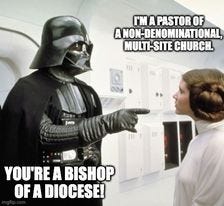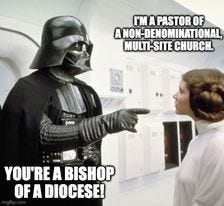Are Multi-Site Churches Good?
A Better Way to Do Church or a Sell-Out to Consumer Christianity?
An ecclesial phenomenon we have to deal with in the twenty-first century is that of multisite churches.
According to research I’ve seen, as many as 10% of all American Protestants now worship in a multisite church and 10% of all Americans rely exclusively on the internet for their religious experiences.
Like it not, it is true that “the multi-site phenomenon is growing dramatically among churches of all sizes, bringing it soon to every city, every denomination, and every style of ministry.”[1] As long as we have internet, multisite churches are going to be a part of the landscape, so they require some form assessment as a way of doing church.
In terms of governance, many of these churches are led by a board elected by a congregation, the board, in turn, appoints a senior minister, with various sites or campuses where each one has a local leadership team subordinate to the senior minister. While there is a large diversity of leadership models for these multisite churches, they look like a miniature diocese within a congregationalist church.
A further factor consideration is the increasing significance of networks rather than denominations.
Most multisite churches are part of networks of like-minded churches, parachurch ministries, seminaries, and mission agencies, unified by common conferences, social media interaction, shared websites, and a common theological ethos. In many ways, networks, like The Gospel Coalition, Hillsong, Missio Alliance, City to City, and various charismatic associations (some of these are linked to specific churches), have displaced denominations as the leaders, hub, and resource for church planting and renewal.
Brad Christerson and Richard Flory describe the factors that made independent network Christianity possible, including: globalization with increased cultural pluralism, the digital revolution with interactive media, and declines in bureaucracies and institutional loyalty.[2] They see Protestant Christianity as becoming increasingly beholden to religious entrepreneurs with the result that “religious groups that are organized around networks will continue to gain market share in the near future, while traditionally organized denominations and congregations will continue to lose market share.”[3]
In other words, multisite mega-churches and various networks are likely to be the tectonic plates of evangelical/charismatic Christianity in the west for the foreseeable future.
There are several rationales and benefits for multisite churches:
(1) I would be prepared to argue the Apostle Paul, Apostle Peter, John the Elder, and John the Seer wrote to networks of churches in various regions. For example, Paul wrote to the “churches of Galatia” (Gal 1:2), and he could refer to the “churches of Judea” (Gal 1:22; 1 Thess 2:14), the “churches of the province of Asia” (1 Cor 16:19), and the “Macedonian churches” (2 Cor 8:1). In other words, Paul knew about churches in areas that were clustered, genetically related, networked, and interdependent, which is kind of analogous to multisite churches.
(2) A pastor overseeing multiple assemblies is nothing new. A Presbyterian minister in the Church of Scotland can have a pastoral charge over several parishes (a former colleague of mine ministering in the western isles of Scotland required a rowboat to reach two of his parishes). Methodist ministers often travel around a circuit visiting several locations. Even a local Baptist church might have three or four congregations that meet on Sunday including a Hispanic or Mandarin congregation who worship in the same building and are part of a church. You could say that multisite churches are just doing the same thing with the internet and good connectivity.
(3) Christians have always used the latest technology for mission and church planting, whether that was the codex, the printing press, radio, television, data projectors, iPods, or the internet.
(4) Multisite churches are an economically efficient way of growing a church besides building a massive Taj Mahal auditorium at great expense and they allow worship sites to be placed where the people actually live.
(5) Multisite churches are a great way of helping struggling rural churches that might only have 10-50 members and cannot afford a full-time minister (based on my experience this is something that I think is required in sparse parts of Scotland and Australia).
(6) Multisite churches are a great way of setting up a church plant that is on the way to becoming independent, autonomous, and contextual.
Those benefits aside, and notwithstanding the diversity among multisite churches, I can definitely see negative consequences to multisite churches too:
(1) Multisite churches raise huge problems about the independence and autonomy of the many sites. If you are, say, a Baptist, and if you believe in the independence and autonomy of the local church, then should the worshippers at a given site determine the ministers, worship, use of finances, and mission of the congregation? If you allow a senior minister and a central hub to control the finances, leadership appointments, even the worship and preaching roster of all sites, then you have basically capitulated to an episcopal form of church government that is more centrally controlled than any Catholic or Anglican diocese in church history. I have to confess that telling my Baptist friends that their multisite church governance is de facto episcopalian leaves me with a case of Schadenfreude that is so acute that I may need to be hospitalized.
(2) The biggest danger of multisite churches is that it risks amplifying the very worst of western evangelical sub-culture which is consumerism, corporatism, and celebrity pastor cults.
(3) Multisite churches can struggle with pastoring to the local needs, particular realities, and resident demographics of its sites. It would be unhelpful to stream a worship service from the middle-class Anglo/Asian suburbs of eastern Melbourne into the working class, welfare-dependent, and ethnic minority suburbs of western Melbourne. The pastors needs to be among the people to lead them in worship, the word, and to administer the sacraments, knowing who they are and what they are going through in their environment.
(4) We must wrestle with the question as to whether sites/campuses are part of a church or constitute a church in their own right. One could argue that if the saints meet for worship, to hear the word preached, and to receive the sacraments, then it is a church, not an extension of another church, not merely a consumer of the mother church’s ministry. Indeed, the Anglican definition of a congregation is: “The visible Church of Christ is a congregation of faithful men [and women], in which the pure Word of God is preached, and the Sacraments be duly ministered according to Christ’s ordinance, in all those things that of necessity are requisite to the same.”[4] If so, should a site/campus be treated like an individual church with its own leadership and identity?[5]
I do not see multisite churches disappearing any time soon, however, the use of technology in doing church must be subordinated to overriding principles about the nature and purpose of the church itself. In addition, we may have to face the fact that senior ministers of these multisite churches need to be trained in episcopal forms of leadership, becoming “episcopal rectors” so to speak, who are able to blend their missional and ecclesiological convictions into a virtual episcopal structure (the term “episcopal rectors” comes from +Rick Thorpe I’m told). I would seriously propose pastors of large multisite churches attending training events held for bishops in the Catholic and Anglican churches if their multisite churches are going to resemble a diocese of sorts.
Come study with me at Ridley College for BTh, BMin, Grad Dip, MDiv, MTh, or PhD. We have a vibrant campus life, worldclass online degrees, and one of the best PhD programs in the world in divinity studies. In addition, there is also the FREE Ridley Certificate. Check out Ridley’s podcast and chapel talks too!
[1] Geoff Surratt, Greg Ligon, and Warren Bird, A Multi-Site Church Road Trip: Exploring the New Normal (Grand Rapids: Zondervan, 2009), 14-15, 94.
[2] Brad Christerson and Richard Flory, The Rise of Network Christianity: How Independent Leaders are Changing the Religious Landscape (Oxford: OUP, 2017), 15-16.
[3] Brad Christerson and Richard Flory, The Rise of Network Christianity: How Independent Leaders are Changing the Religious Landscape (Oxford: OUP, 2017), 165.
[4] 39 Articles § 19.
[5] See the pointed critique on this point by Jonathan Leeman, “Theological Critique of Multi-Site: What Exactly is a ‘Church’?” 9 Marks. 30 Sept 2010. https://www.9marks.org/article/theological-critique-multi-site-what-exactly-church/. Accessed 30 August 2018.





Celebrity pastors and massive amounts of money often takes the focus away from God. That is the main reason I do not like Mega churches. They become corporations and are more concerned about the bottom line than teaching the word.
This is good, especially in looking at church structure and planning. However, it would be good to also dive deeper into why people want to attend multi-site churches. What is the draw? Why did they not choose a church that uses another model? What does it mean for discipleship?